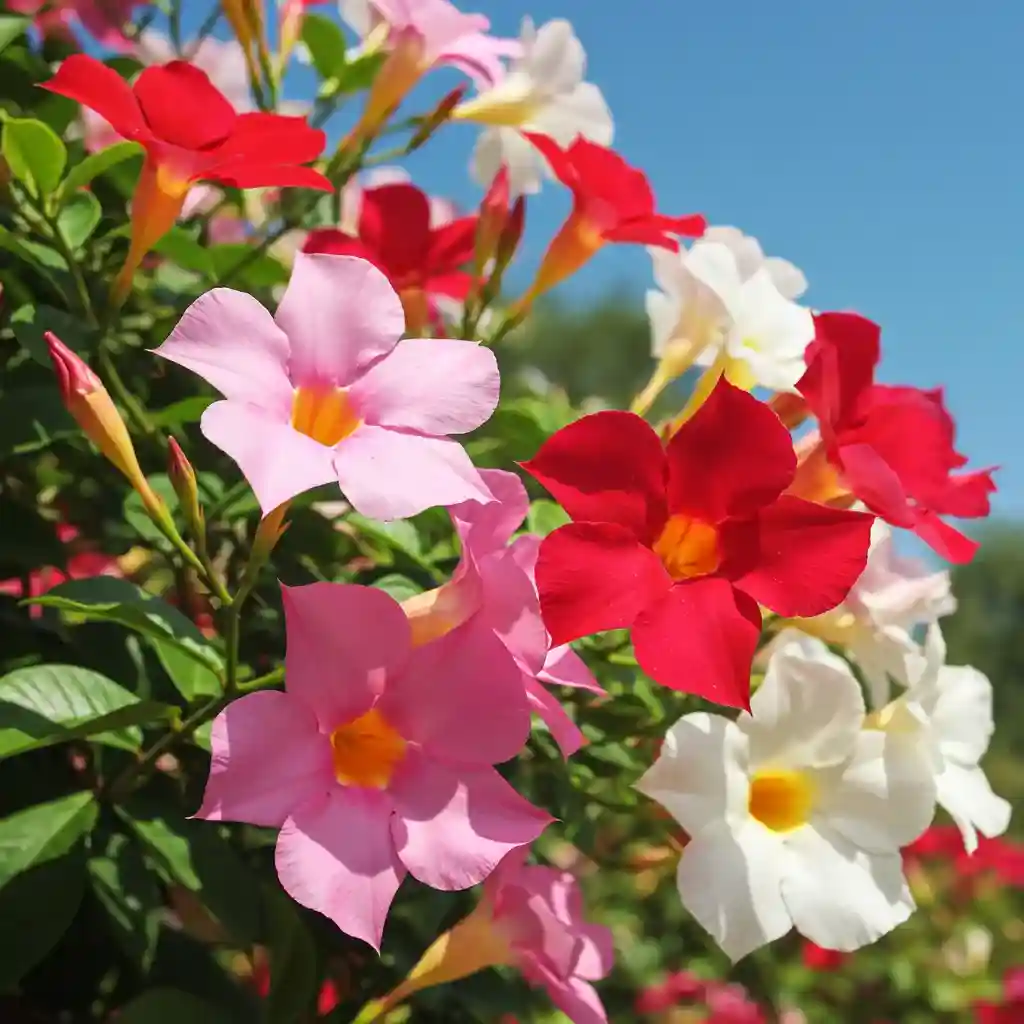Are you ready to transform your garden into a vibrant paradise? Look no further than Mandevilla colors—the dazzling tropical vine that brings an explosion of hues to any space! Whether you’re a seasoned gardener or just starting, Mandevilla’s stunning shades will leave you breathless. From fiery reds to soft pinks and even rare, unexpected tones, this plant is a showstopper.
In this guide, we’ll dive deep into the world of Mandevilla colors, exploring the most mesmerizing varieties, how to choose the perfect shade for your garden theme, rare hues you probably didn’t know existed, expert pairing tips, and seasonal care secrets to keep your blooms radiant. Get ready—your garden is about to become the envy of the neighborhood!
1.Mandevilla Vine: Tropical Blooms with Vibrant Colors
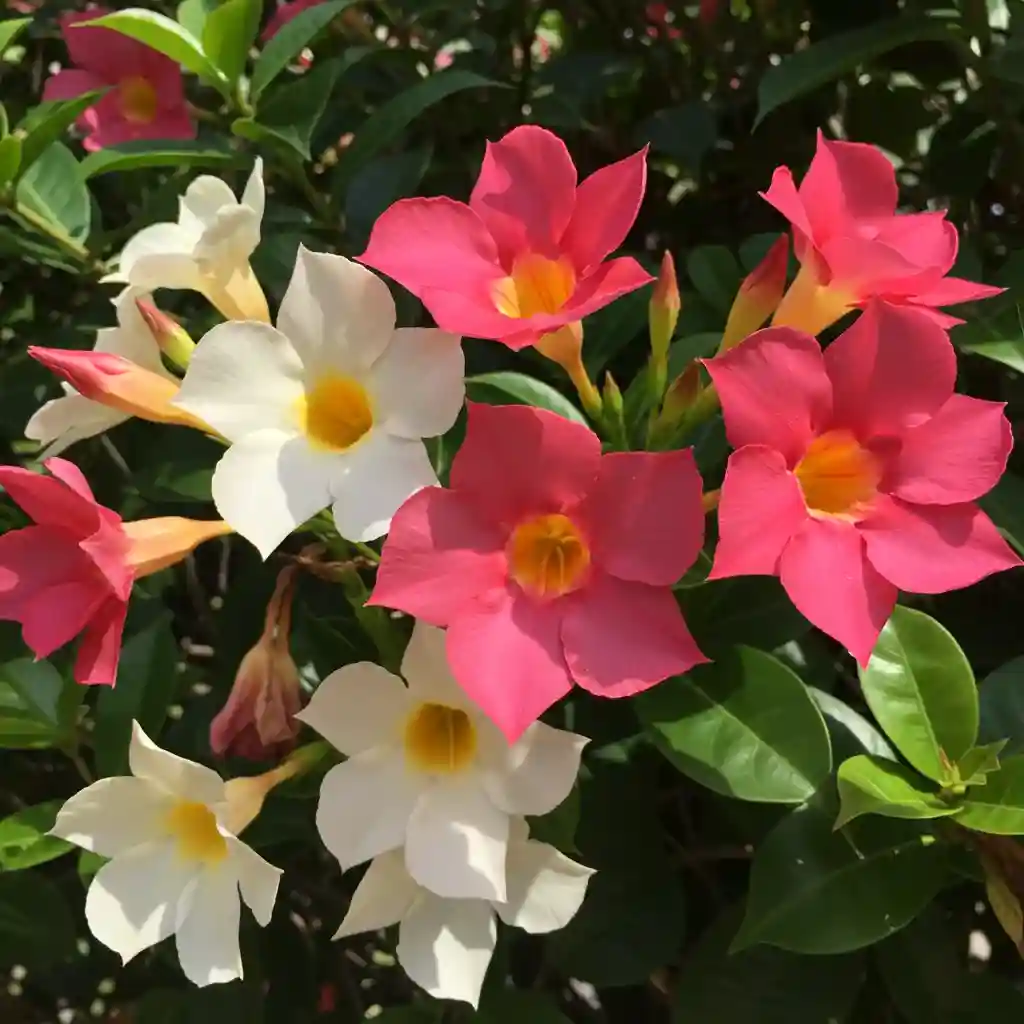
If you haven’t yet fallen in love with Mandevilla, prepare to be amazed! This tropical vine, native to South America, is famous for its trumpet-shaped flowers and lush, glossy foliage. But the real magic lies in its Mandevilla colors—vibrant, bold, and utterly captivating.
Why Mandevilla Stands Out
Unlike many flowering plants that offer limited shades, Mandevilla boasts a spectrum of colors that can match any garden aesthetic. Here’s what makes it so special:
-
Vibrant Reds & Pinks – Classic varieties like Mandevilla sanderi (Red Riding Hood) and Mandevilla boliviensis (White) are popular, but did you know there are deep crimsons, neon pinks, and even sunset coral tones?
-
Sun-Kissed Yellows & Whites – For a softer touch, creamy whites and buttery yellows (like Mandevilla ‘Sun Parasol’) add elegance.
-
Bicolor Marvels – Some hybrids feature stunning dual-tone petals, blending pink and white or red and yellow for an eye-catching effect.
Growth Habits & Care Basics
Mandevilla thrives in warm climates (USDA zones 9-11) but can be grown as an annual or in containers elsewhere. It loves:
-
Full sun to partial shade (6+ hours of sunlight for best blooms).
-
Well-draining soil (slightly acidic to neutral pH).
-
Regular watering (keep soil moist but not soggy).
With proper care, your Mandevilla colors will flourish, creating a breathtaking vertical or cascading display.
2. Choosing the Right Mandevilla Colors for Your Garden Theme
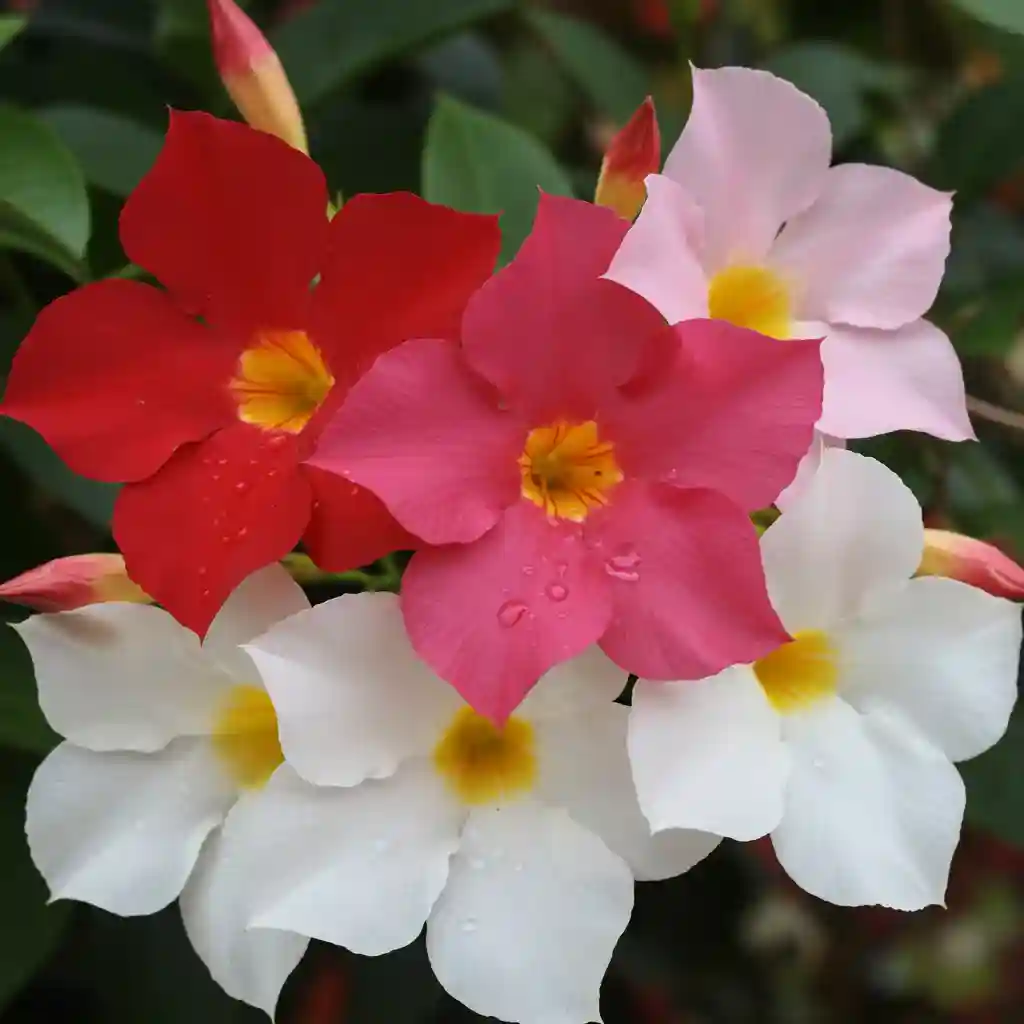
Not sure which Mandevilla colors will complement your garden? Let’s break it down by theme so you can pick the perfect hue!
Tropical Paradise Theme
If you crave a lush, exotic vibe, go for bold, saturated Mandevilla colors:
-
Fiery Red (‘Crimson Fantasy’) – Pairs beautifully with hibiscus and bird-of-paradise.
-
Hot Pink (‘Pink Parfait’) – Stunning against deep green palms.
Romantic Cottage Garden
For a softer, dreamy look, opt for:
-
Soft Pink (‘Rosea’) – Perfect with lavender and roses.
-
Pure White (‘Aloha White’) – Adds elegance alongside climbing hydrangeas.
Modern Minimalist Garden
If your style is sleek and contemporary, try:
-
Deep Burgundy (‘Bordeaux’) – Striking against white walls or concrete planters.
-
Sunshine Yellow (‘Sun Parasol Giant Yellow’) – Brightens monochromatic spaces.
Pro Tip:
Use contrasting foliage (like silver dusty miller or purple heuchera) to make your Mandevilla colors pop even more!
3. Rare Mandevilla Colors You Didn’t Know Existed
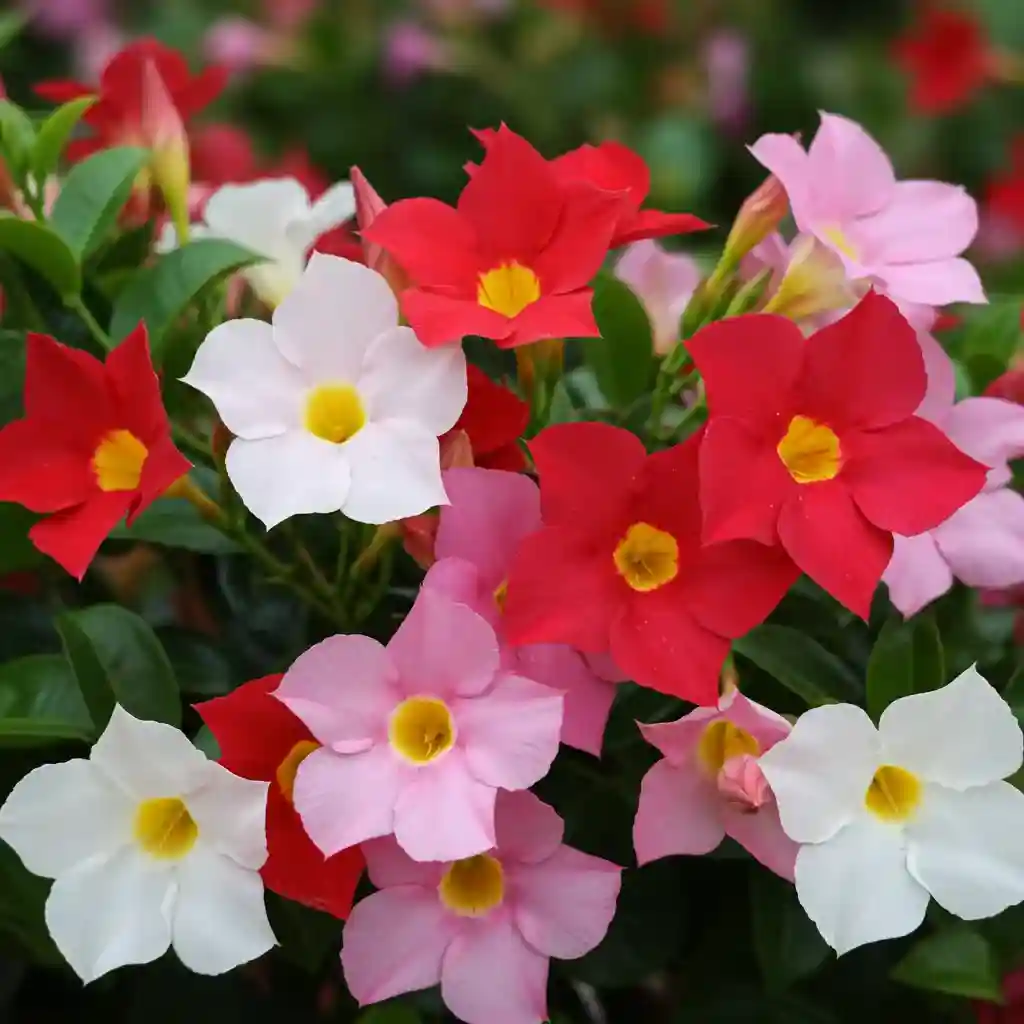
Think you’ve seen all the Mandevilla colors? Think again! Some rare and unusual varieties will blow your mind.
1. ‘Black Truffle’ Mandevilla
Yes, black flowers exist! This deep, velvety burgundy appears almost black in certain light—ideal for gothic or moody gardens.
2. ‘Cosmic Pink’ Mandevilla
A rare hybrid with neon pink petals and a golden-yellow throat—like a sunset in bloom!
3. ‘Moonlight’ Mandevilla
A near-luminous white with a faint greenish tint, glowing under moonlight—perfect for night gardens.
Where to Find These Gems
Check specialty nurseries or online exotic plant sellers. These rarities may cost more, but the wow factor is worth it!
4. How to Pair Mandevilla Colors with Other Flowering Plants
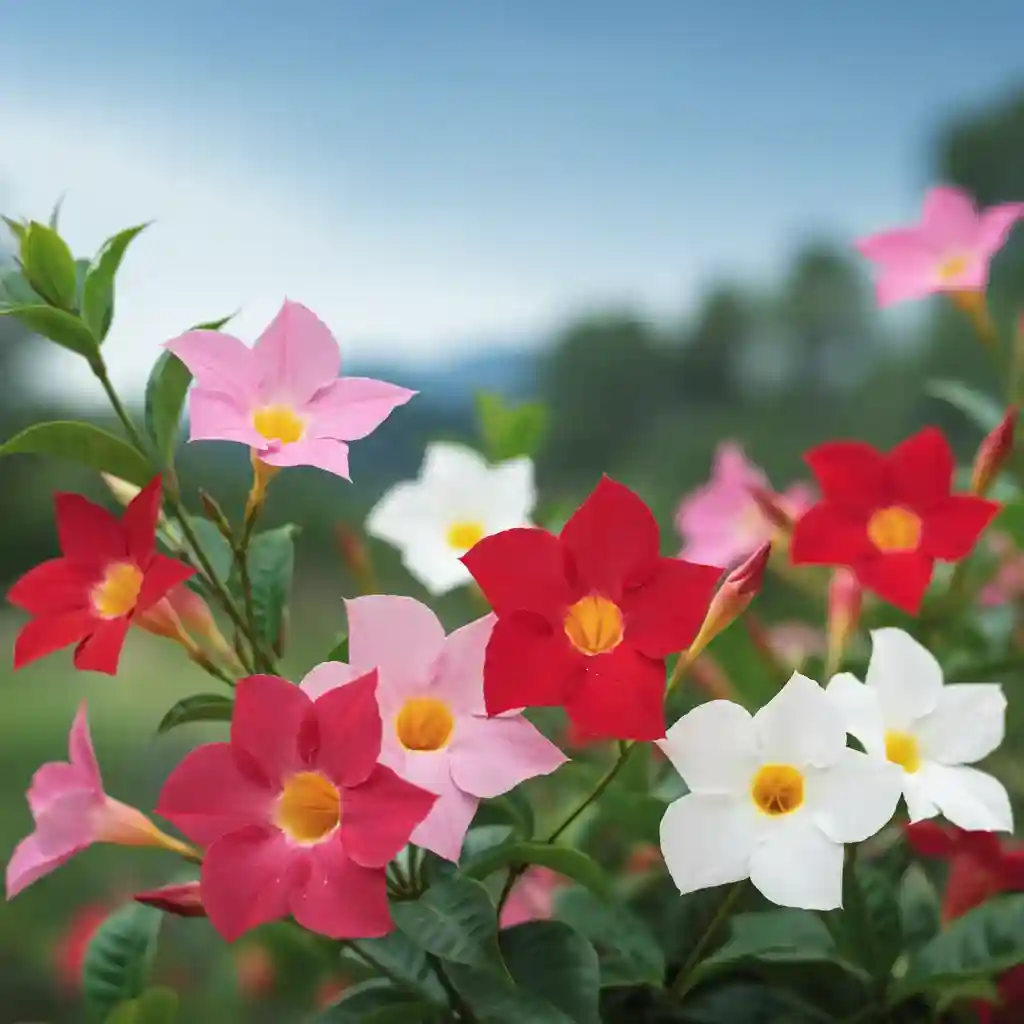
Want your Mandevilla colors to shine even brighter? Strategic pairings make all the difference!
Best Companion Plants for Mandevilla
-
Purple & Blue Flowers (Salvia, petunias) – Contrasts beautifully with pink/red Mandevillas.
-
Golden Blooms (Marigolds, lantana) – Complements yellow/white Mandevillas.
-
Foliage Plants (Coleus, caladium) – Adds texture without competing for attention.
Design Tricks
-
Vertical Layering – Grow Mandevilla on a trellis with clematis for multi-color height.
-
Container Combos – Pair trailing Mandevilla with upright plants like geraniums for dynamic pots.
5. Seasonal Tips to Keep Your Mandevilla Colors Blooming Bright
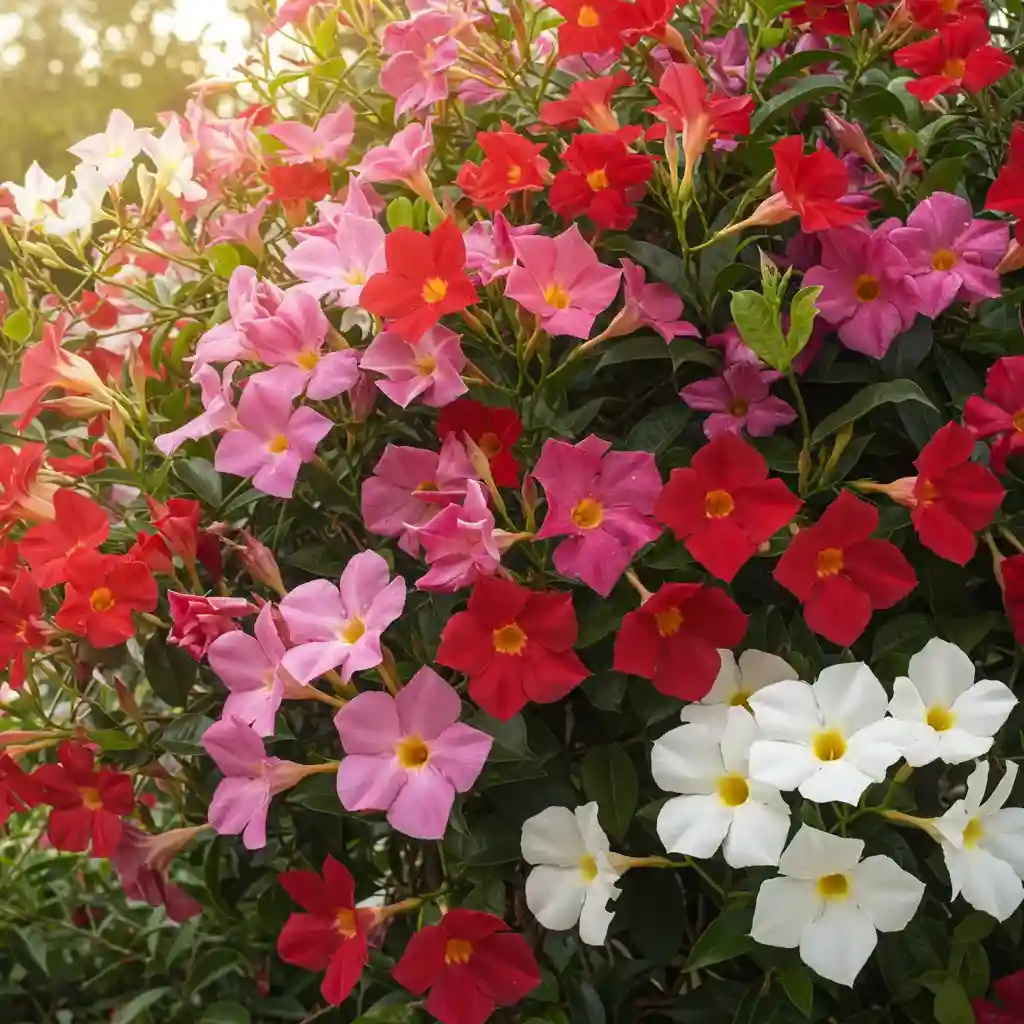
Want year-round brilliance? Follow these seasonal care tips!
Spring & Summer
-
Fertilize every 2 weeks (high-phosphorus formula for blooms).
-
Prune lightly to encourage bushiness.
Fall & Winter
-
Bring indoors if temperatures drop below 50°F.
-
Reduce watering but keep in bright light.
Pest Control
Watch for aphids/spider mites—neem oil works wonders!
Conclusion
There you have it—the ultimate guide to Mandevilla colors that will make your garden the talk of the town! From classic reds to rare near-black blooms, this vine offers endless possibilities. By selecting the right hues, pairing them strategically, and maintaining seasonal care, your garden will burst with life and color.
So, what are you waiting for? Pick your favorite Mandevilla colors, get planting, and prepare for a garden that’s nothing short of spectacular! 🌸✨
FAQ About Mandevilla Colors
1. What are the most common Mandevilla colors?
The most popular Mandevilla colors include:
-
Bright Red (e.g., ‘Crimson Fantasy’)
-
Hot Pink (e.g., ‘Pink Parfait’)
-
Pure White (e.g., ‘Aloha White’)
-
Sunshine Yellow (e.g., ‘Sun Parasol Giant Yellow’)
These classic shades are widely available and perfect for adding tropical vibes to any garden!
2. Are there rare or unusual Mandevilla colors?
Yes! Some rare Mandevilla colors you might not know about include:
-
‘Black Truffle’ (deep burgundy, almost black)
-
‘Cosmic Pink’ (neon pink with a golden throat)
-
‘Moonlight’ (luminous white with a greenish tint)
These unique varieties can be found at specialty nurseries or online exotic plant shops.
3. Can Mandevilla grow in cooler climates?
Mandevilla thrives in warm climates (USDA zones 9-11) but can be grown as an annual or in containers in cooler regions. To overwinter it:
-
Bring indoors before frost.
-
Place near a sunny window (at least 6 hours of light).
-
Reduce watering but keep soil slightly moist.
4. How do I keep my Mandevilla blooming all season?
For continuous Mandevilla colors, follow these tips:
-
Full sun (6+ hours daily).
-
Fertilize every 2 weeks (use a high-phosphorus bloom booster).
-
Deadhead spent flowers to encourage new blooms.
-
Prune lightly to maintain shape and promote bushiness.
5. What plants pair well with Mandevilla?
For a stunning garden display, pair Mandevilla colors with:
-
Purple flowers (Salvia, petunias) for contrast.
-
Golden blooms (Marigolds, lantana) for warmth.
-
Trailing foliage (Sweet potato vine, coleus) for texture.
6. Why are my Mandevilla flowers fading or dropping?
Common reasons include:
-
Over or under-watering (keep soil moist but not soggy).
-
Lack of sunlight (needs 6+ hours of direct light).
-
Pests (check for aphids/spider mites—treat with neem oil).
7. Can Mandevilla grow in shade?
While Mandevilla prefers full sun, it can tolerate partial shade. However, too little light may reduce blooming intensity.
8. How fast does Mandevilla grow?
Under ideal conditions, Mandevilla can grow 3-10 feet in a single season! Provide a trellis or support for climbing varieties.
9. Is Mandevilla toxic to pets?
Yes, Mandevilla is toxic to cats and dogs if ingested. Keep it out of reach or opt for pet-safe plants if needed.
10. Where can I buy rare Mandevilla colors?
Check:
-
Specialty nurseries
-
Online exotic plant retailers (Etsy, Logee’s, PlantVine)
-
Local garden clubs or plant swaps

